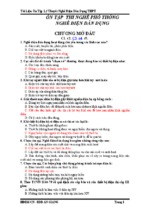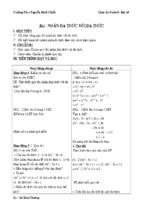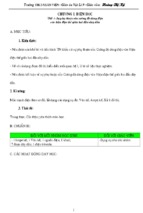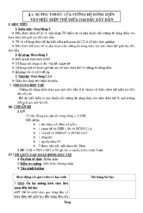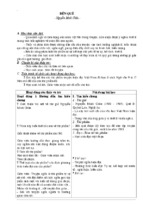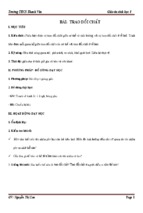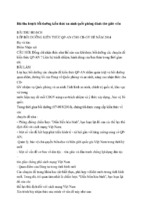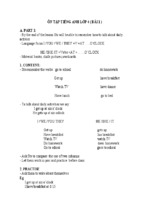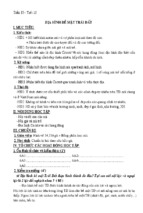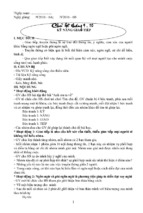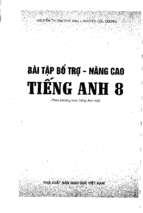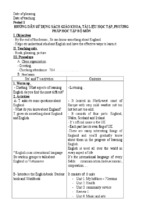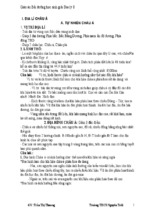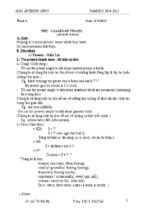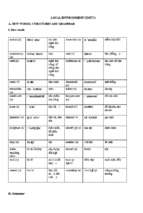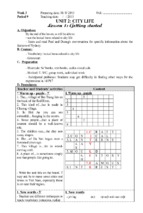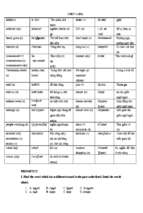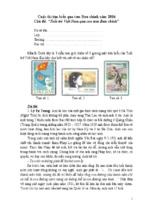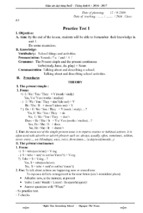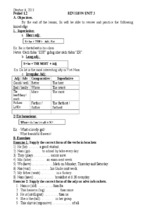Ngày soạn: 08/08/2016
Ngày dạy: 22/8/2016
Tiết 1
REVISION AND TESTING
I. Objectives:
- To introduce the textbook- English 11
- To introduce the way of testing.
- To set up some class regulations.
- To revise what they have already learned.
- To give a fifteen- minute test.
II. Procedures:
1. Textbook introduction:
a. Contents: - Six themes: + You and me
+ Education
+ Community
+ Nature and the environment
+ Recreation.
+ People and places.
- Sixteen units.
b. The Structure of the book: - There are sixteen units. In each unit, there are five main parts:
Reading, Speaking, Listening, Writing, and Language focus including Pronunciation and Grammar
as well as Vocabulary.
2. The system of testing
3. A thirty- minute test
Choose the best answer
1. Everyone likes him, ……………?
A. doesn’t he
B. doesn’t she
C. don’t they
D. don’t you
2. ……………..Christmas, the weather has been quite good.
A. From
B. Since
C. On
D. For
3. Nam is interested in …………… English.
A. learning
B. to learn
C. learn
D. learned
4. Most people enjoy …………….to different parts of the world.
A. traveling
B. to travel
C. traveled
D. travel
5. There …………. never ……………. such excitement before.
A. has/ been
B. have / been
C. will / been
D. is / been
6. I ………………David James for two weeks.
A. has seen
B. saw
C. see
D. have not seen
7. The baby …………..wonderfully up to now.
A. behaves
B. is behaving
C. has behaved
D. behaved
8. I've been in this city for a long time. I ……………….. here sixteen years ago.
A. come
B. am coming
C. came
D. have come
9. -I'm going to the library to borrow some books.
-Sorry, I've got to go, …………….!
A. see you later
B. thank you
C. good morning
D. not at all
10.- …………….did you see him ?
-I saw him two days ago.
A. what
B. when
C. why
D. which
11. Don’t forget ………………. the letter I gave you.
A. posting
B. post up
C. post
D. to post
Read the following passage and then choose the best answer to the questions
Charles Dickens, a social novelist, was born at Portsmouth. His father, a poor government servant,
was arrested and imprisoned for debt. Therefore he had to earn his living at eleven in a factory.
1
Dickens had very little schooling; most of his education was acquired from the books. He read and
the experiences. He lived later he taught himself short- hand and became a newspaper reporter.
12. Where was Charles Dickens born?
........................................................................................................................
13. How was his family?
........................................................................................................................
14. When did he begin to work?
........................................................................................................................
15. Was he a teacher at last?
........................................................................................................................
Read the following passage carefully and then choose the best option to fit each numbered
blank
The country and the city have advantages and disadvantages. People in the country live in more
beautiful (16) _____. They enjoy peace and quiet, and their neighbors are (17) _____ and ready to
help them when they need it. However, their life can be tiresome and they can be isolated.
The city has all the services the country lacks, but it also has a lot of (18) _____. Cities are often
ugly and (19) _____. They not only have bad air but are also noisy. Everyone is always in haste and
this means that people have no time to know each other and (20) _____ friends.
16. A. surroundings
B. view
C. sightseeing
D. scenery
17. A. friend
B. friendly
C. friendship
D. friends
18. A. disadvantage
B. benefits
C. advantages
D. disadvantages
19. A. polluted
B. pollutant
C. pollution
D. polluting
20. A. make
B. making
C. having
D. has
Make meaningful sentences, using the words / phrases provided.
21. There/ so/ on/ street/ is/ traffic/ the/ much.
=>………………………………………………………………………
22. love/ English/ I/ learning.
=>………………………………………………………………………..
23. have/ Would/ to/ a/ you/ drink/ like?
=>………………………………………………………………………..
Make question for these answers.
24. .................................................................................................................. ?
James tries to find a solution for this problem.
25....................................................................................................................?
I’m going to Ha Noi next week.
- The end Comments:
................................................................................................................................................................
................................................................................................................................................................
................................................................................................................................................................
................................................................................................................................................................
............................................................................................................................................................/.
2
Ngày soạn: 08/08/2016
Ngày dạy: .../8/2016
Tiết 2
REVISION AND TESTING
I. Aims:
- To examine what students have learnt and how they understand the knowledge gained.
- To help students revise the knowledge learned.
II. Procedures:
1. Thirty minute test correction
- Teacher helps students to correct the thirty-minute test they did last period.
- Teacher gives some further explanation about grammar and further exercises if necessary.
ANSWER KEYS OF THIRTY-MINUTE TEST
Choose the best answer
1. C 2. B 3. A 4. A 5. A 6. D 7. C 8. C 9. A 10. B 11. D
Read the following passage and then choose the best answer to the questions
12. He was born at Portsmouth.
12. His father, a poor government servant, was arrested and imprisoned for debt.
14. He began to work at the age of eleven.
15. No, he wasn’t.
Read the following passage carefully and then choose the best option to fit each numbered
blank
16. A 17. B 18. D 19. A 20. A
Make meaningful sentences, using the words / phrases provided.
21. There is so much traffic on the street.
22. I love learning English.
23. Would you like to have a drink?
Make question for these answers.
24. Who tries to find a solution for this problem?
25. When are you going to Hanoi.
Further exercises:
Choose the word whose underlined part is pronounced differently.
1). A). of
B). off
C). safe
D). knife
2). A). torch
B). worn
C). work
D). torn
3). A). swear
B). hear
C). dear
D). spear
4). A). though
B). cough
C). rough
D). tough
5). A). think
B). thus
C). thin
D). thick
Choose the word whose main stress is in a different position
6). A). decide
B). struggle
C). historic
D). prepare
7). A). enjoyment
B). development
C). entertainment
D). environment
8). A). accuse
B). approximately
C). final
D). deny
9). A). promotion
B). technique
C). consider
D). material
10). A). dangerous
B). marathon
C). tropical
D). performance
Choose the best answer.
11). He's very poor, and he has ................. possessions.
A). few
B). any
C). little
D). a little
12). We took ..................... of the fine weather and spent the day on the beach.
A). effect
B). advantage
C). occasion
D). chance
13). She is leaving her husband because she can not put ................ his bad temper any longer.
A). up
B). away
C). off
D). up with
14). It's time we ................ away with our old-fashion prisons.
3
A). have done
B). did
C). do
D). shall do
15). Betty is quite ............................ of cooking a meal for twelve people.
A). efficient
B). expert
C). capable
D). clever
16). When I saw Jane, I stopped and smiled, but she ............... me and walked on.
A). refused
B). ignored
C). denied
D). omitted
17). A learner driver must be .................... by a qualified driver.
A). associated
B). connected
C). accompanied
D). involved
18). He ............... a policeman; he is much too short.
A). must be
B). can't be
C). looks like
D). should be
19). As far as I'm ............., it's quite all right for you to leave early.
A). consulted
B). concerned
C). regarded
D). bothered
20). She wondered ..................... her father looked like now, after so many years away.
A). what
B). how
C). that
D). whose
21). Don't be late for the interview, ............... people will think you are a disorganized person.
A). unless
B). otherwise
C). if not
D). or so
22). Some people .................... at least four hours a day watching TV.
A). use
B). last
C). take
D). spend
23). ....................... of the committee, I'd like to thank you for your generous donation.
A). Together
B). In addition
C). According
D). On behalf
24). The government made serious attempts to raise the ..................... of living.
A). standard
B). level
C). mode
D). cost
25). ...................... I realised the consequences, I would never have contemplated getting involved.
A). Had
B). If
C). When
D). Unless
26). It was ...................... hot day that we decided to leave work early and go to the beach.
A). a so
B). such a
C). so
D). such
27). If we continue to ..................... the world's resources at this rate, there will soon be none left.
A). damage
B). use up
C). finish
D). throw away
28). There was no ....................... in waiting longer than half an hour so we left.
A). good
B). worth
C). point
D). use
29). She warned me ..................................
A). not to do it
B). to not do it
C). I should do it
D). about to do it
30). In my mother's ................., it is essential to eat a big breakfast.
A). principle
B). opinion
C). confidence
D). idea
ANSWER KEYS FOR FURTHER EXERCISES
1. A 2. C 3. A 4. A 5. B 6. B 7. C 8. C 9. B 10. D 11. A 12. B 13. D 14. B 15. C 16. B
17. C 18. B 19. C 20. B 21. B 22. D 23. D 24. A 25. A 26. B 27. B 28. D 29. A 30. B
- The end Comments:
................................................................................................................................................................
................................................................................................................................................................
................................................................................................................................................................
................................................................................................................................................................
............................................................................................................................................................/.
4
UNIT 1: FRIENDSHIP
I. AIMS
1. Knowledge:
General knowledge:
By the end of lesson, Ss should be able to:
Talk about the qualities of friendship: unselfishness, constancy, loyalty, trust and
sympathy.
Give some general tips to keep a friendship long.
Language:
Infinitive with “to” and without “to”
Vocabulary: words to talk about friendship
Phonics: / dʒ/ and / tʃ/
2. Skills:
Speaking: By the end of lesson, Ss should be able to describe physical characteristics and
personalities in order to talk about a famous friend.
Listening: By the end of lesson, Ss should be able to understand two monologues of for
general or specific information about best friends.
Reading: By the end of lesson, Ss should be able to understand a passage of 250-320 words
about friendship
Writing: By the end of lesson, Ss should be able write about a friend.
II. METHODS: integrated, mainly communicative
III. TEACHING AIDS: pictures, handouts, cassette, tapes, and posters
IV. ANTICIPATED PROBLEMS:
Ss may not fully understand the meaning of some words and phrases (constancy, loyalty,
sympathy...), so T should be ready to help them.
Ss may make noise when talking about their friend, so T should set out some rules to take
control the whole class.
V. PROCEDURE:
5
Ngày soạn: 11/8/2016
Ngày dạy: .../.../2016
Tiết: 3
A: READING
1. Objectives:
By the end of lesson, Ss should be able to
Understand a passage of 250-320 words about friendship
Use vocabulary related to the topic to talk about the qualities of friendship
Guess the meaning of the words from the context
2. Teaching aids: cassette, tape, PowerPoint
3. Procedure:
Steps +
Time
Learning activities
Warm-up
Music
(5’)
(Sts have chance to listen to the song: I got a
friend by Carole King)
Language focus
Modes
Vocabulary
Whole class
Vocabulary of picture
description
Pair work
Q: What do you think of the friend in the poem?
Pre-reading Picture Description
(10’)
(Look at the picture, ask and answer the
questions:
1. How many people are there in the
picture?
2. What are they doing?
3. Are they friends or acquaintances?)
Presentation
Vocabulary and
structures:
(Introduce some new words)
Game: matching
(Ss match the words in column A with their
Vietnamese meaning in column B)
Acquaintance (n)
to be capable of (v)
unselfishness (n)
constancy (n)
loyalty (n)
suspicious (a)
trust (n)
sympathy (n)
enthusiasm (n)
Individual
Group
Vocabulary
6
Whilereading
(17’)
Task 1: Gap-filling
Vocabulary:
(Ss choose the right word to complete each
sentence)
Answer keys:
1. mutual
Pair
acquaintance (n)
incapable of (a)
mutual (a)
unselfish (a)
give-and-take
(n)
2. in capable of
3. unselfish
4. acquaintance / friend
friend (n)
loyal to (a)
suspicious (a)
5. give-and-take
6. loyal to
7. suspicious
Task 2: Multiple choice
(Ss choose the most idea that adequately sums
up the whole passage)
Pair
Vocabulary
Answer key: D
Group
Task 3: questions answering
Vocabulary and
(Ss answer the questions basing on the passage) grammar
Postreading
Discussion
(Ss discuss the question ‘Why do we need to
have friends?’, then report the results of
discussion to the class)
Homework Ss learn by heart all the new words
Ss read the passage at home and practice
(3’)
translate it into Vietnamese
Vocabulary
Group
Vocabulary
Individual
(10)
Comments:
................................................................................................................................................................
................................................................................................................................................................
................................................................................................................................................................
................................................................................................................................................................
............................................................................................................................................................../.
Friday, August..., 2016
Comment and signature of the group leader
Nguyen Thi Huong Que
7
Ngày soạn: 15/8/2016
Ngày dạy: .../.../2016
Tiết: 4
B: SPEAKING
1. Objectives:
By the end of lesson, Ss should be able to:
Describe people’s physical characteristics and their .personalities, as well.
Use the words of the topic to describe their friends.
Exchange information about their friends by playing game: role-play.
2. Teaching aids: Ss’ textbooks, T’s lesson plan, pictures, handouts
3. Procedure:
Steps +
Time
Learning activities
Language focus
Warm-up
Network
(5’)
(Ask Ss to work in two big groups find out (handsome, beautiful, tall,
as many words used to describe physical short, kind-hearted, badcharacteristics and personalities as possible) tempered, hospitable...)
Prespeaking
Reading and choosing
Vocabulary
(Ss study words used to describe physical
characteristics and personalities)
(about physical
characteristics and
personalities)
(7’)
Vocabulary
Modes
Group work
individual
* crooked (a): khoằm
* good - natured (a): tốt tính
* modest (a): khiêm tốn
* sincere (a): chân thành
* studious (a): chăm chỉ
* quick-witted (a): nhanh
nhẹn
* caring (a): chu đáo
Whilespeaking
Task 1: Describing physical
characteristics
(20’)
(Ss describe people in the pictures as the
example)
Vocabulary
Grammar
(Ss describe their friends’ appearance)
Task 2: Describing personalities
(Ss describe their friends’ personalities)
Task 3: Role-play
Pairs
Pairs
vocabulary
Vocabulary
Pairs
8
(Ss make conversations between an
Grammar
interviewer as a journalist and an
interviewee as the one who has just won the
first international prize in Mathematics)
Post –
speaking
Report
vocabulary
(8’)
(Ss act out the conversations in front of the grammar
class)
Homework
Guiding
(5’)
(Guide Ss to practice describing at home
and people at home and prepare the next
lesson: Listening)
vocabulary
pairs
individual
Comments: ...........................................................................................................................................
................................................................................................................................................................
.....................
9
Ngày soạn: 20/8/2016
Ngày dạy: .../.../2016
Tiết: 5
C: LISTENING
1. Objectives:
By the end of lesson, Ss should be able to
- Understand the talks about the topic “best friend” of two people Lan and Long
- Use the information they have listened to do the exercises and discuss the conditions to
become best friends
2. Teaching aids: cassette, PowerPoint
3. Procedure:
Steps +
Time
Learning activities
Language focus
Warm-up
Game: Jumbled-words
Vocabulary
(5’)
(Ask Ss to find out the words in correct order) ( favourite, guitarist,
motorbike, friendly,
humourous)
Prelistening
Discussion
(7’)
1. Who is your best friend?
Vocabulary
Modes
Group work
Individual
(Ss ask and answer the questions)
individual
2. How did you happen to meet him or her?
3. How long have you known each other?
4. What qualities do you admire in your best
friend?
Presentation
Vocabulary:
(Introduce some vocabulary)
apartment building
sense of humour
guitarist
favourite
motorbike
around
Whilelistening
T or F
(20’)
Table completion
Post –
listening
Vocabulary
individual
(listen again and note down the ideas in the
table given)
vocabulary
individual
Discussion
vocabulary
groups
(Listen and decide the statements are T or F)
(Ss take turn to talk about how Ha has been
10
(8’)
Lan’s best friend and how Minh has been
Long’s best friend)
Homework
Guiding
(5’)
(Guide Ss to write a paragraph of 140 words
about Ha’s talk or Long’s talk basing on their
discussion in class and prepare the next lesson:
Writing)
vocabulary
individual
Comments:
................................................................................................................................................................
................................................................................................................................................................
................................................................................................................................................................
................................................................................................................................................................
................................................................................................................................................................
11
Ngày soạn: 20/8/2016
Ngày dạy: ..../..../2016
Tiết: 6
D: WRITING
1. Objectives:
By the end of lesson, Ss should be able to
- Write about a friend, real or imaginary using the prompts.
2. Teaching aids: PowerPoint, writing samples, blank papers, color pens
3. Procedure:
Steps +
Time
Warm-up
(5’)
Learning activities
Language focus
Modes
Picture drawing
Vocabulary to
Groups
(Ss work in small groups, one look at a picture and describe the pictures
describe everything he sees so that the other can
draw the picture. When the describer is finished,
compare the drawings to the real thing! Whose is
the closest to the original?)
Pre-writing Presentation
(10’)
Vocabulary and
(Some verbs and structures used to describe a structures used to
describe a person
person)
* to be...tall
Discussion
* to be at the age
What rules do you have in your family?
of...
* to make a good
Presentation
Individual
Groups
Individual
impression on sb..
(Structure of an informal letter)
Structures of a
description
Whilewriting
Writing practice
Vocabulary
(Write about a friend, real or imaginary)
Grammar
Cross-checking
Vocabulary and
grammar
individual
(15’)
Postwriting
(Ss exchange their writing for peer-checking)
Pairs
(10’)
Comments
(Two Ss write their writing on the board then the
others and T give comments)
Homework Guiding:
Whole class
Individual
12
(5’)
T guide Ss to rewrite their description at
home
Ask Ss to prepare the next lesson part E
Language focus
Comments:
................................................................................................................................................................
................................................................................................................................................................
................................................................................................................................................................
................................................................................................................................................................
............................................................................................................................................................../.
Friday, September..., 2016
Comment and signature of the group leader
Nguyen Thi Huong Que
13
Ngày soạn: 20/8/2016
Ngày dạy: .../..../2016
Tiết: 7
E: LANGUAGE FOCUS
1. Objectives:
By the end of lesson, Ss should be able to
- Distinguish and pronounce correctly the ending sounds / dʒ/ and / tʃ/
- Use correctly infinitive with to and infinitive without to
2. Teaching aids: PowerPoint, cassette, posters
3. Procedure:
Steps + Time
Learning activities
Warm-up
Tongue twisters.
(5’)
- Joe is joking John about Jane.
Language focus
Modes
Phonic / dʒ/ and / Individual
tʃ/
- Which picture does the child want to change?
Pronunciation Listening and repeating
Phonics
Individual
(12’)
(Ss listen to the teacher pronounce two sounds and
words then repeat)
/ dʒ/ and / tʃ/
Practicing reading aloud
Phonics
Pairs
Grammar
Groups
Grammar
Individual
Grammar
Individual
Grammar
Pairs
(Ss read aloud the sentences paying attention to two
sound / dʒ/ and / tʃ/)
Grammar
Game: Table completion
(25’)
(Ss work in 4 groups to complete the tables about the
positions of infinitive with to and infinitive without to
in sentences)
Presentation
T give comments on the completed tables and add
lack information if necessary
Practice exercises
(Ss work in pairs to do 2 exercises in the textbooks)
Exercise 1: Ordering words to make sentences
Exercise 2: Rewriting sentences
14
Homework
(3’)
Guiding:
Grammar
T guide Ss to revise infinitive at home
Ss prepare the next lesson: pre-reading part A- Vocabulary
Reading, unit 2
Individual
Individual
Comments:
................................................................................................................................................................
................................................................................................................................................................
................................................................................................................................................................
................................................................................................................................................................
............................................................................................................................................................../.
15
UNIT 2: PERSONAL EXPERIENCES
I. AIMS
1. Knowledge:
General knowledge:
By the end of lesson, Ss should be able to:
Understand and talk about one of the most embarrassing experiences happened in
the past.
Appreciate family more than other things.
Language:
Tense revision: Present simple indicating past time; the past simple, past progress
and past perfect
Vocabulary: words to talk about personal experiences: embarrassing,
unforgettable, memorable, terrified...
Phonics: /m/, /n/, /ŋ/
2. Skills:
Speaking: By the end of lesson, Ss should be able to talk about one of their past experiences
and how it affected them.
Listening: By the end of lesson, Ss should be able to comprehend an interview about the
most unforgettable experience in Christina’s life.
Reading: By the end of lesson, Ss should be able to understand the passage about the most
embarrassing experience of a little girl.
Writing: By the end of lesson, Ss should be able write a personal letter about a past
experience using suggestion.
II. METHODS: integrated, mainly communicative
III. TEACHING AIDS: Ss’ textbooks, pictures, handouts, cassette, tapes, posters, chalks, board…
IV. ANTICIPATED PROBLEMS:
Ss may find some terms in the text difficult to understand so T should deliver the lesson
carefully.
Ss may not understand how to distinguish the formal letter and informal one, so teacher
should give clear comparison.
V. PROCEDURE:
16
Ngày soạn: 22/8/2016
Ngày dạy: .../.../2016
Tiết: 8
A: READING
1. Objectives:
By the end of lesson, Ss should be able to
Guess the content of the story basing on pictures
Explain the meaning of the words/phrases in the sentences
Talk about the most memorable experience.
2. Teaching aids: posters, PowerPoint
3. Procedure:
Steps +
Time
Learning activities
Warm-up
Game: guessing
(5’)
Ss order the pictures and guess the
content of the story
Language focus
Modes
Vocabulary
Groups
Pre-reading Vocabulary pre-teaching
Vocabulary:
Individual
(10’)
embarrassing (n)
to glance at sb (v)
sneaky (a)
to make a fuss (v)
Whilereading
Give Ss the meaning and
pronunciation of some words and
phrases
Task 1: Gap-filling
Ss fill the suitable words in the blanks
(20’)
Vocabulary:
glanced
making a fuss
embarrassing
idols
sneaky
Task 2: Reordering
Ss check their ordering pictures
basing on the events of the story.
Individual
Groups
Vocabulary
Task 3: Questions answering
17
Game: Lucky pictures
Ss read the passage then ask and
answer the questions
Postreading
Discussion
Vocabulary:
Groups
She
gave
money
to
the
boy
and
What do you think the girl had to do
after she discovered that the money said sorry to him.
she had taken from the boy’s bag was - She put money into the boy’s bag
without being recognized and said
not hers??
nothing.
...
(7’)
Homework Guiding:
(3’)
T guide Ss to learn by heart all new
words they have just learnt
Ss prepare the next lesson: pre-read
part B: SPEAKING
Vocabulary
Individual
Comments:
................................................................................................................................................................
................................................................................................................................................................
................................................................................................................................................................
................................................................................................................................................................
............................................................................................................................................................../.
18
Ngày soạn: 22/8/2016
Ngày dạy: .../.../2016
Tiết: 9
B: SPEAKING
1. Objectives:
By the end of lesson, Ss should be able to
Talk about the experiences and how they might have affected them
Use structures and ideas in samples to make similar dialogues about past experiences.
2. Teaching aids: handouts, PowerPoint
3. Procedure:
Steps +
Time
Learning activities
Warm-up
Homework checking
(5’)
Check Ss’ homework in order to examine how they
understood the past lesson.
Prespeaking
Presentation
(12’)
T gives the meaning and pronunciation of
some words/phrases
Language focus
Modes
Vocabulary
Grammar
Groups
Vocabulary:
Individual
+ appreciate (v)
+ to make sb + V(inf.) (v)
+ attitude (n)
Whilespeaking
(15’)
Task 1: Matching
Vocabulary:
Pairs
Ss match the things they might have done or
experienced in box A with how the experience might
have affected them in box B.
Task 2: Re-jumbling conversation
Ss reorder the sentences to make a complete
conversation.
Vocabulary
Pairs
Ss practice the conversation in front of the class.
Task 3: Monologues
Ss talk about one of their past experiences and how it
affected them, using the suggestions in Tasks 1 and 2
Groups
19
Postspeaking
Vocabulary
(10’)
Report
Ss talk about one of their unforgettable memorable
and how it affected you.
Homework
Guiding:
Vocabulary
(3’)
Ss learn by heart all new words they have just
learnt
Ss prepare the next lesson: pre-read part C:
LISTENING
Individual
Grammar
Individual
Comments:
................................................................................................................................................................
................................................................................................................................................................
................................................................................................................................................................
................................................................................................................................................................
............................................................................................................................................................../.
Friday, September..., 2016
Comment and signature of the group leader
Nguyen Thi Huong Que
20
- Xem thêm -


